![]()
The Point Loma Lost "Meteorite"
Last reported in a 1904 newspaper article.
Image location: The historical (Old) Point Loma Lighthouse is located in the Cabrillo National Monument at the southern tip of Point Loma in San Diego.
First and foremost, I would like to acknowledge "Dolan" Dave Libuszowski for informing me about this possible "meteorite". Being the consummate prospector that he is, Dave was data-mining the Internet when he discovered this newspaper article from 1906:
Los Angeles Herald, Volume XXXI, Number 288, 13 July 1904
"MADE IMPORTANT DISCOVERY" - Lighthouse Keeper Finds Meteor [sic] on Point Loma
SAN DIEGO. July 12 (Special).— Capt. R. A. Weiss, keeper of the lighthouse on Point Loma, has made an Important discovery of a meteor which fell In 1875, and has lain in the ground near the lighthouse ever since. Capt. Welss came across in the records of the lighthouse, the account of the falling of the meteor and the directions where it had struck. He followed them and had the gratification of locating the stone. The meteor [sic] was found to be very large, too large to be taken out of the ground in whole, so several chunks of it, which had broken off in the fall, were recovered. The specimens are very rare indeed, as there are very few examples of such rock in this country. Mr. Weiss believes there are other interesting articles to be found on the Point and with the help of the lighthouse records will make a search.

Map of Point Loma in San Diego
1) Captain Weiss was the lighthouse-keeper for Point Loma in 1906 --
An important fact to keep in mind is that there are two Point Loma Lighthouses; the "Old" and the "New" (the current lighthouse). The "New" one was built in 1890. Captain Weiss was the keeper of the "New" lighthouse from 1904 to 1908.
2) Captain Weiss "came across in the records of the lighthouse" an entry from 1875 describing a meteor event --
Another important fact to keep in mind is that Captain Weiss was reading "the records" from the "Old" Lighthouse and not from the records for his "New" Lighthouse, which wasn't built until 1890. As of this writing, these "records" have not been located.
3) In 1875 the fall of a meteor was witnessed and recorded in the lighthouse keeper's log --
It is a matter of record that Captain Robert Decatur Israel was the Lighthouse Keeper at the "Old" Point Loma Lighthouse in 1875. It is assumed that he made the entry into the Keepers Log, except that his wife, Maria Arcadia Machado de Alipas Israel, was also the Assistant Lighthouse Keeper and she may have been authorized to make the entry. In addition, there were 4 children, making for a family of six people living at the lighthouse, and it is not known (at least, for now) who or how many of them witnessed the meteor.
4) The Keeper's Log gave an "account of the falling of the meteor and the directions where it had struck" --
The key fact here is the wording, that being "the directions" and NOT the location "where it had struck"!
5) "He followed them and had the gratification of locating the stone." --
Captain Weiss read the account in the log entry and "followed" in the directions (as recorded) in order to find "the stone". (The article is clearly telling us that someone has deemed this a stony meteorite, as opposed to an iron meteorite. Who was this "someone"? Did the article rely upon Captain Weiss to make that determination?)
6) If the stone was near the lighthouse and was so easy to be located, why did it take 30 years for it to be found? --
Since Captain Weiss started working as the keeper in 1904, this tells us that it took him, at the most, 2 years to locate the "stone". The article doesn't attempt to explain how the log entry helped Captain Weiss to locate in less than 2 years the "stone too large to move", yet for nearly 30 years since the fall, why no one else was able to locate it, or why no one else made the attempt. Could it be that even though the eyewitness knew exactly in which direction the meteorite struck, it was also known to be at such a great distance away to preclude bothering to search for the object? Keep in mind that there was no mention of any sounds or actual visible impact event. As we now know with witnessed fireball events that pass beyond the horizon, interviewed eyewitnesses often assume that "the meteor must have struck in the direction that it was last seen", when in fact, it actually continued travelling 200 km more, before breaking-up at an altitude of 15-30 km.
7) "... and [the meteorite] has lain in the ground NEAR THE LIGHTHOUSE ever since." --
Unfortunately, the newspaper article isn't clear about WHICH LIGHTHOUSE, but it is more than likely it meant the "Old" Lighthouse. If that assumption is true, it would be important because that would most likely place the find location within the Cabrillo National Monument. If not true, it would substantially increase the area to search for the find location, and would encompass the entire south end of Point Loma to include the U.S. Coast Guard facility at Pelican Point.
8) "... so several chunks of it, which had broken off in the fall, were recovered. " --
The article recounts that samples of the found "stone" were successfully obtained. But what is not made completely clear is whether these "several chunks which had broken off" were assumed to have broken off while in flight (thus, having formed a strewn-field), or if the chunks had broken off directly from the found mass from its assumed impact with the ground. Nor does the article confirm who made the determination that the pieces "broken off in the fall" were indeed paired to the large main-mass. Having personally found a broad scattering of round, iron-rich concretions in the vicinity of the historical lighthouse, I must admit to being suspicious that there may have been a misidentification by non-professionals of those chunks collected back in 1904.
9) "The specimens are very rare indeed, as there are very few examples of such rock in this country." --
Again, the wording of the article confirms that there were several "specimens" recovered. The comment about the rarity "of such rocks" is probably just a general statement of fact about there being "very few examples" of meteorites, and not likely a specific statement confirming that these specimens have been authenticated as being "very rare".
Determining what ever was the final disposition of these specimens is an important objective of this research.
Finding just one of these specimens would be crucial to answering many of these questions.
Rediscovering the original find location, not to mention the main-mass (especially, if it is still in-situ), would be tantamount to bringing this entire story to a full circle.
To this end, several experts in various fields of expertise have been contacted (names withheld):
Librarian - National Archives, Records of the Bureau of Lighthouses and its Predecessors
Historian - Cabrillo National Monument, San Diego, CA
Historian - self-employed civilian who specializes in the history of Point Loma.
Resident - currently the oldest living former resident of the Point Loma Lighthouse.
Resident - currently resides in Point Loma and found a meteor-wrong on his property.
The Smithsonian Institute meteorite collection manager has also been contacted, but will be "out-of-the-office until September 1st", and consequently can't contribute to this report, and can't be included in the above list. The rationale for involving the Smithsonian is based on the fact that Captain Weiss was a government employee and the samples were found on federally-managed land. By default, and as was the custom back at that time, the samples would have been shipped back east and eventually turned over to the Smithsonian for authentication and curation. It is very possible that these samples could have made it all the way to the Smithsonian before they were properly examined. This begs the question, 'Were these samples classified, and if they were determined to be non-meteoritic, would there still be a record of this?"
As I've already stated, the newspaper article is all the evidence we have regarding this "meteorite". So far, none of the people that I have contacted have been able to add any corroborating or tangible evidence to substantiate the statements in the 1904 newspaper article.
But, among those involved in this research, I've found it curious that their opinions about this "Lost Meteorite" are forming into two polarized camps. One camp seems to be of the opinion that the newspaper article is sufficient evidence to prove that the meteorite actually exists, and that samples of it must be residing in the vast Smithsonian collection as one of their many "unclassified meteorites". That camp is insisting that the Captain Weiss find be recognized as California's first "fall", and that it is incumbent upon the Smithsonian to prove otherwise.
The other camp is diametrically opposed to all of that, and is of the opinion that this is all about the fixation over a "probable meteor-wrong" that was self-authenticated by a bored lighthouse-keeper. Coupled with the shoddy journalism by the LA Herald newspaper, where their investigation failed to separate fact from opinion, we have nothing more than back-page fluff that somehow survived all the way into the Internet-age.
To me, I find that camp's opinion to be harsh, but I also understand why they are so jaded. In the recent decades there have been too many instances of the media reporting of "rocks that just have to be meteorites because we saw them fall just over the hill, and besides there was a meteor shower last night!" (for example, just do a Google search on "Freehold New Jersey meteor-wrong").
There is a very exhaustive list compiled by my learned colleague, Ken Newton, on his Meteorite Mis-identification In the News Website.
And since my article may have the same effect as the original newspaper article, that of seeming to confirm the Captain's story, I feel I should side with the "show me" camp. Besides, having personally found a variety of meteor-wrongs at this very locality, doesn't give me confidence in the Captain's story, even though I would very much love to rediscover his "meteorite".
Nevertheless, it would be very helpful if we could confirm that the "Old Lighthouse" logbook still exists. Once located, we need access to it in order to find the 1875 entry that describes a meteor event. We need to read the very same entry that Captain Weiss read in 1904, which led him to believe that a meteorite from that fall could be found on Point Loma.
We need to break this "cold case". We need some new leads.
We need to bring this subject to a conclusion.
Photo Gallery:
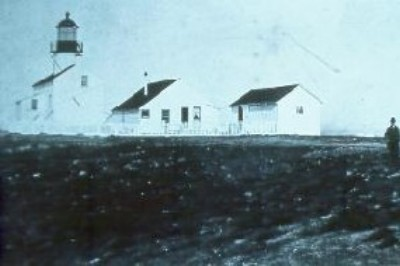
Point Loma "Old" Lighthouse - circa 1875 (NPS Photo)
Note that there is very little vegetation. This may be a cultivated field, but there are certainly very few shrubs.
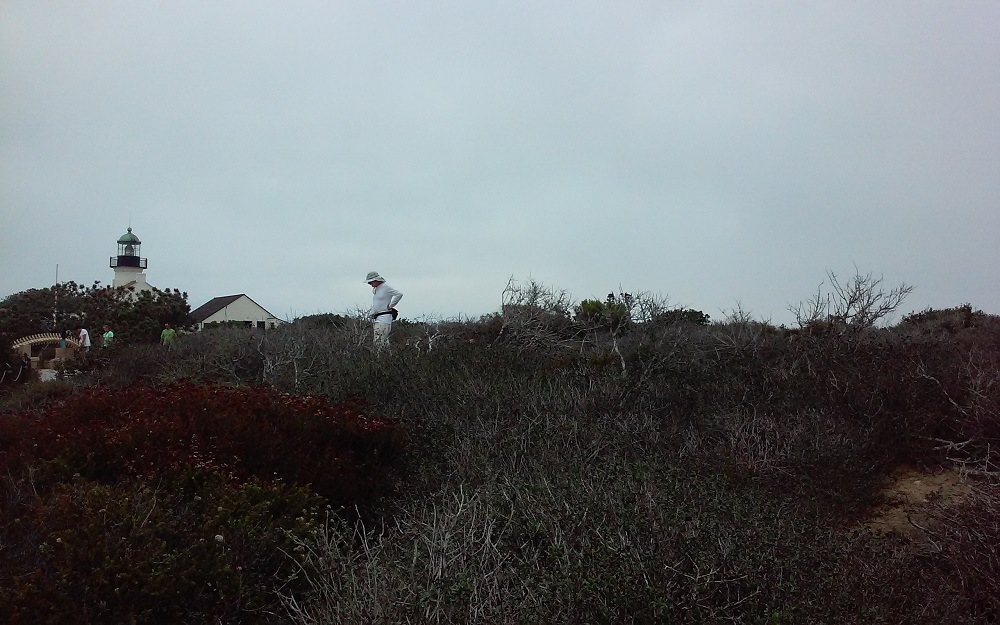
Point Loma "Old" Lighthouse - present day image by Monika Waiblinger (2015).
Note the dense chapparel which made for thick ground-cover and marginal expectations for seeing a meteorite.

Point Loma "Old" Lighthouse - northwest corner (image by author - 2015)
The lighthouse is situated on the highest portion of the topmost bluff that caps the south-end of Point Loma.
This bluff is comprised of a flat layer of sedimentary rock.
Although this is the youngest layer underlying Point Loma, it is also the most weathered layer.
The more iron-rich rocks in this particular layer have been deeply oxidized and are darkly stained.
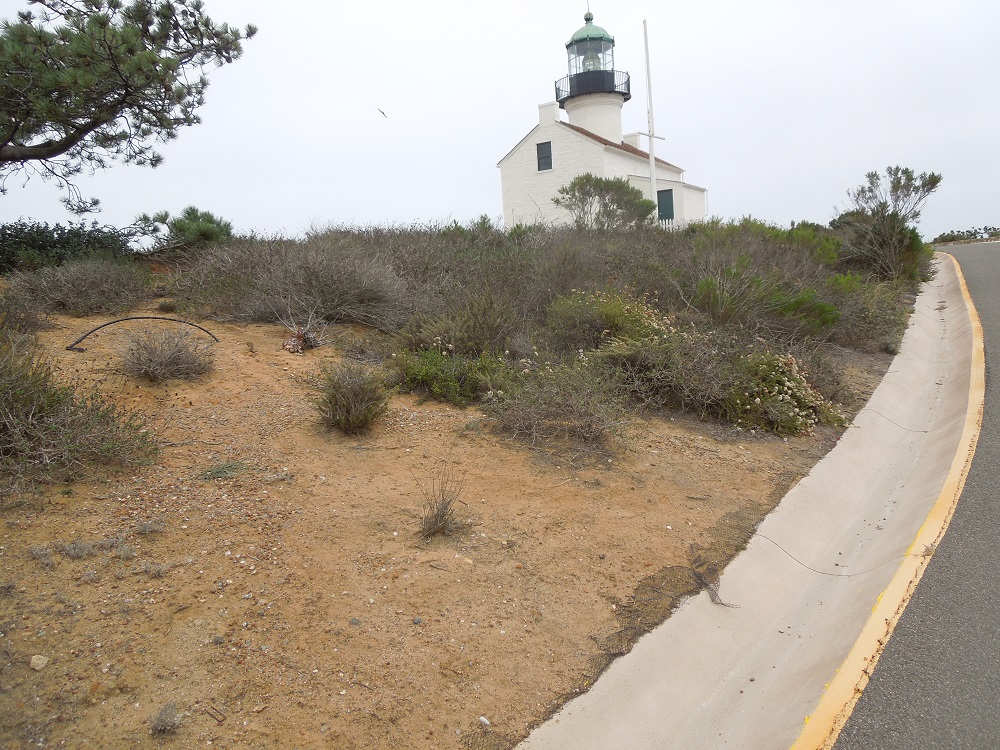
Point Loma "Old" Lighthouse - and the paved access-road leading up to it.
The pebbles seen in the gutter are near-spherical concretions that have weathered-out and rolled-down the slope.
Although they are oxided to a dark-brown, the sand in these concretions are still so magnetite-rich, they are attracted to a magnet.
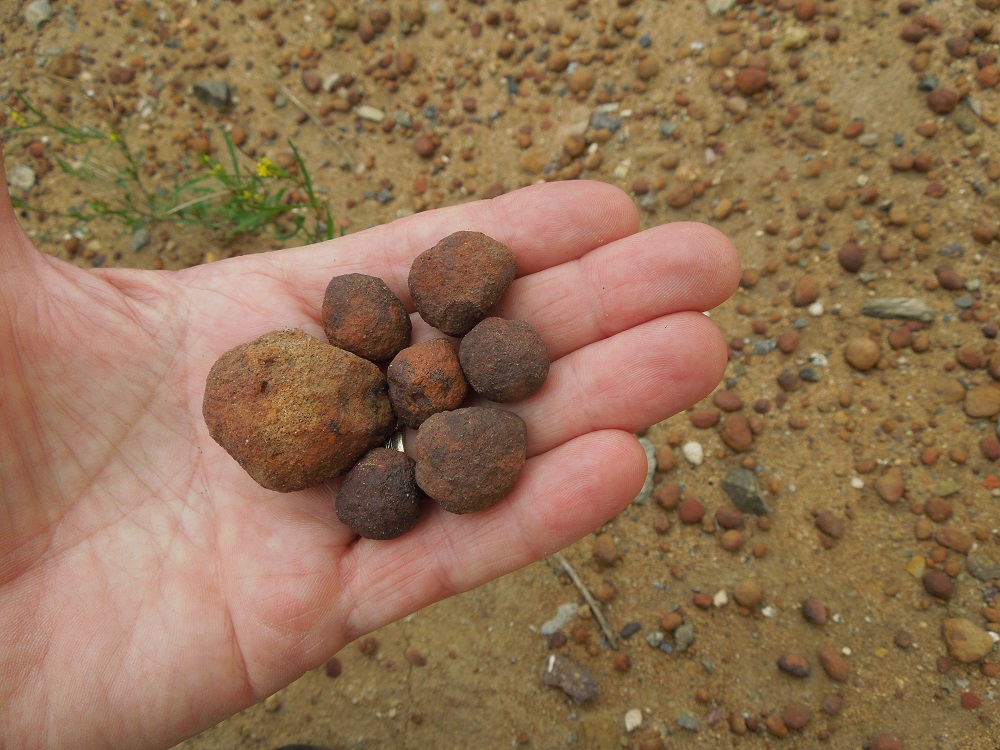
Weathered-out concretions from sediment underlying the "Old" Point Loma Lighthouse.
These were found to have rolled into the gutter and were so iron-rich that they would jump onto a magnet.
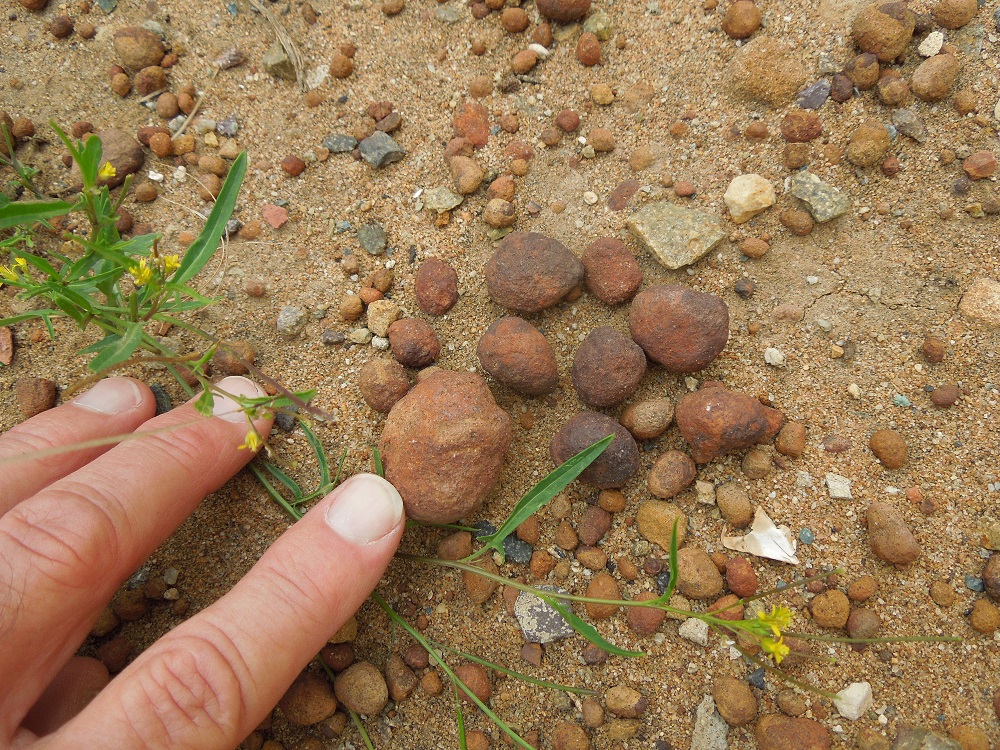
The same concretions after I returned them to the ground where they originated.
Note the variety of sizes for these concretions. Much larger concretions were found exposed in a lower layer of sediment.
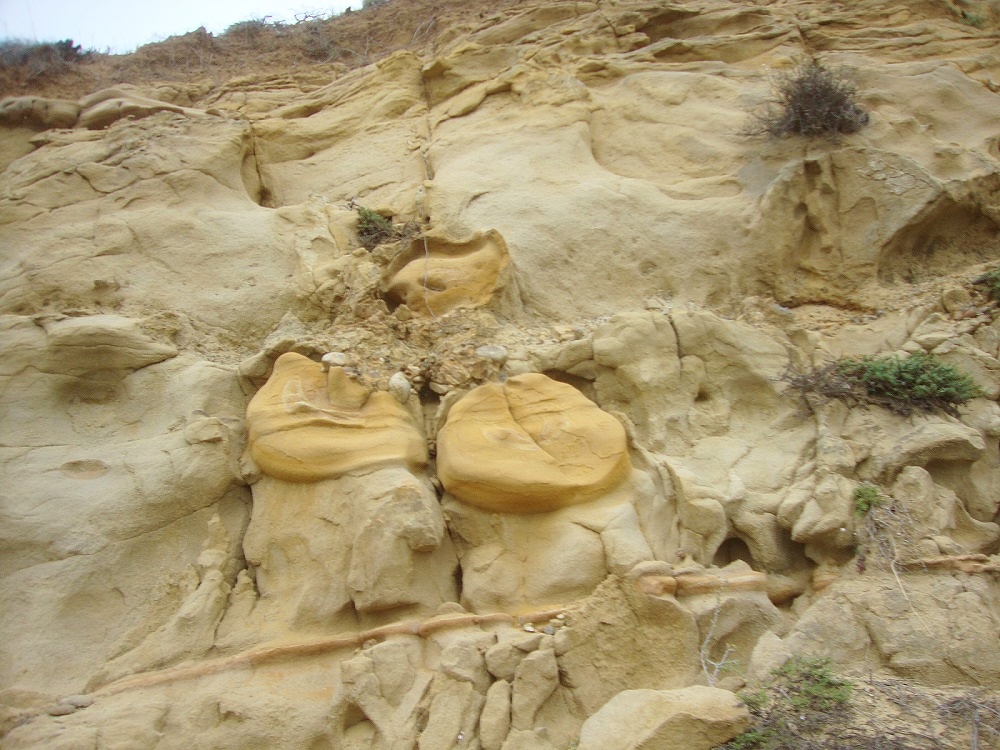
Along the road that connects the "Old" and the "New" Point Loma Lighthouses, there are road-cuts that expose boulder-sized concretions.
These in-situ concretions are in a lower, but less-weathered layer directly below the "Old" Lighthouse.
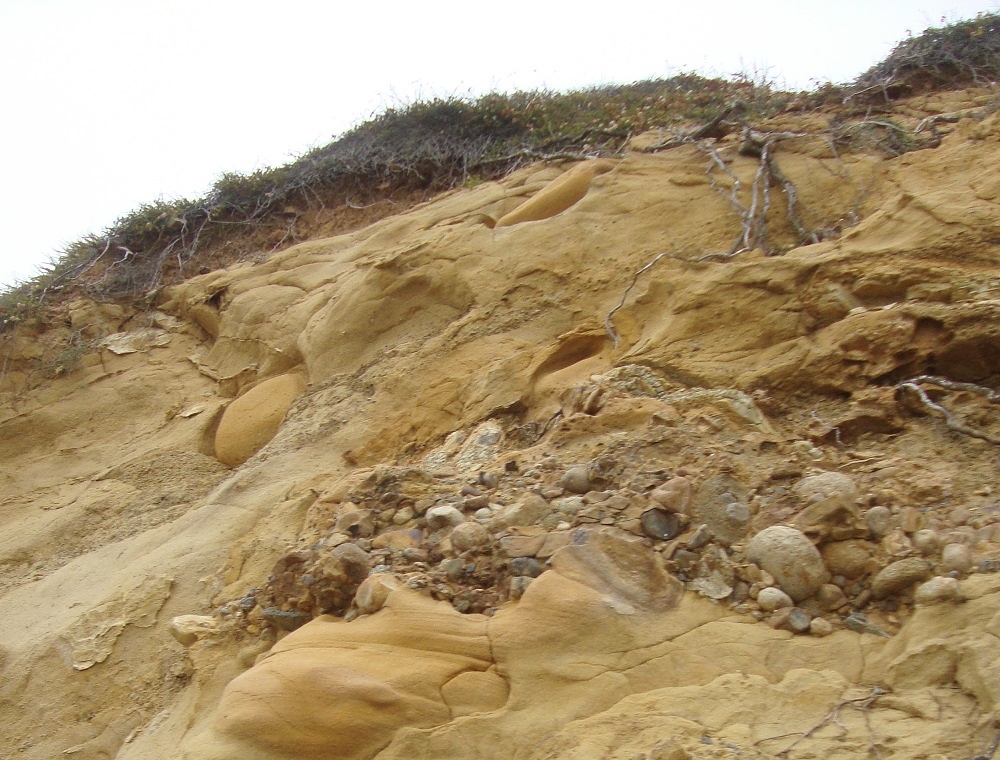
More in-place concretions beneath the "Old" Lighthouse. Some of these are over a meter in diameter.
The concretions at the top of this section appear to be weathering-out. Overlying this is a darkly iron-stained paleosol.
If one of these large, weathered-out concretions were to be found in this paleosol, it would be expected to be dark-stained, as well.
If it was as dark-stained and as attracted to a magnet as the smaller concretions shown above, it could conceivably
be mistaken for a stony meteorite.
Could the "meteorite" that Captain Weiss found in 1904 be one of these kind of concretions?
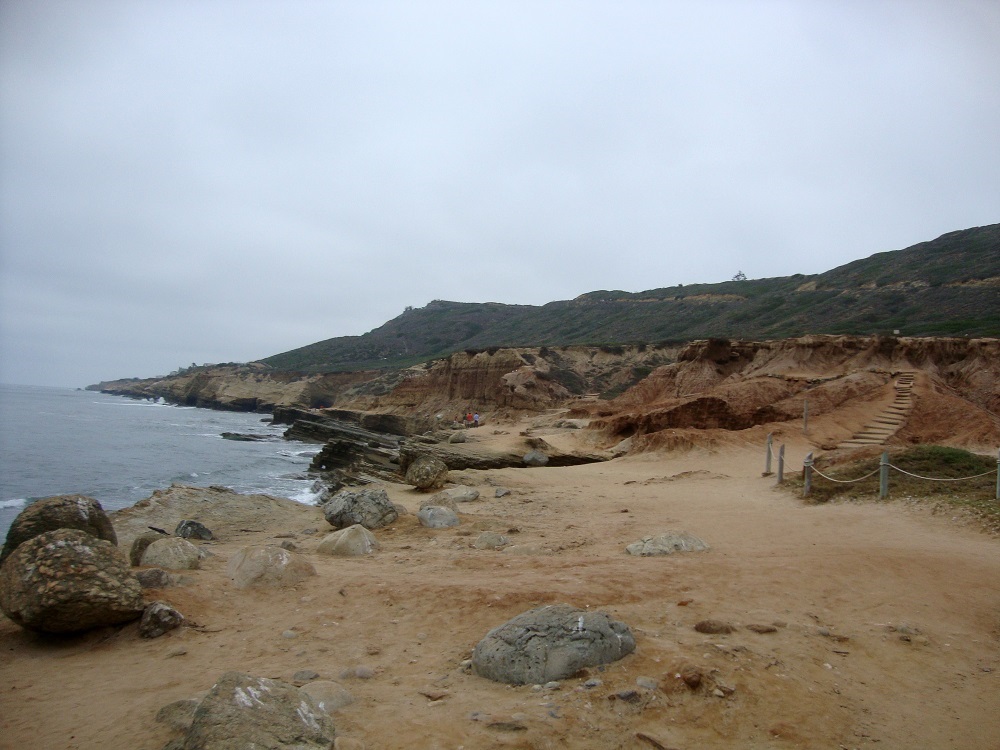
A view to the north-northeast along the west shore of Point Loma in the direction of the "Old" Lighthouse.
In the distance can be seen the road-cuts (with the concretions depicted above) along the road down to the "New" Lighthouse.
Because a low cloud-deck would obscure the "Old" Lighthouse up on the top of the bluff,
the "New" Lighthouse was built at this lower elevation (not far to the right of this image by Monika Waiblinger - 2015).
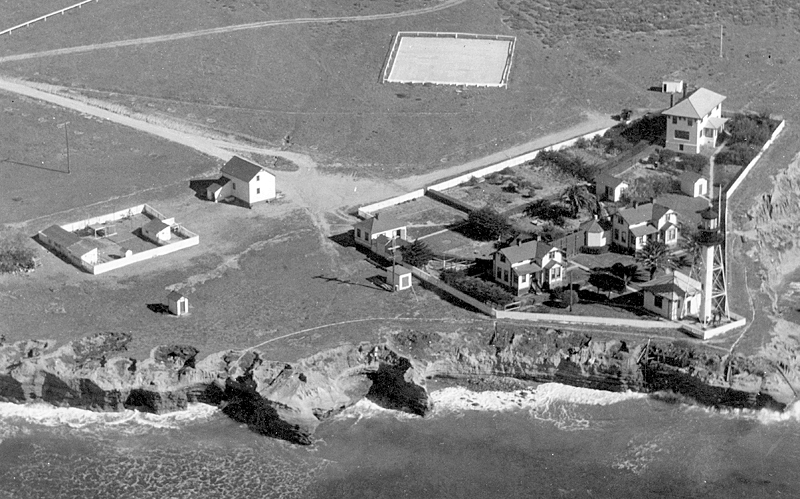
Point Loma "New" Lighthouse at Pelican Point - circa 1934 (NPS photo)
This is the Lighthouse that Captain Weiss was the lighthouse-keeper in 1906, when he read in the old logs about the 1875 Meteor.
But this "new" lighthouse was built in 1885, and hence, did not exist in 1875.
The Meteor of 1875 was witnessed by the lighthouse-keeper for the "Old" Point Loma Lighthouse and
that person made his entry into the "Old Lighthouse" logbook.

Point Loma and the "Old" Lighthouse - recent photo with North Island, Coronado, and San Diego in the background.
Meteoritical Bulletin: the search results for all provisional meteorites found in "USA" - Published by Meteoritical Society - Meteoritical Bulletin, Database.
Meteorites of California the list of formally-recognized California meteorite falls and finds.
Los Angeles Herald, Volume XXXI, Number 288, 13 July 1904
http://tinyurl.com/ozxaaww
"MADE IMPORTANT DISCOVERY" - Lighthouse Keeper Finds Meteor [sic] on Point Loma
SAN DIEGO. July 12 (Special).— Capt. R. A. Weiss, keeper of the lighthouse on Point Loma, has made an Important discovery of a meteor which fell In 1875, and has lain in the ground near the lighthouse ever since. Capt. Welss came across in the records of the lighthouse, the account of the falling of the meteor and the directions where it had struck. He followed them and had the gratification of locating the stone. The meteor [sic] was found to be very large, too large to be taken out of the ground in whole, so several chunks of it, which had broken off in the fall, were recovered. The specimens are very rare indeed, as there are very few examples of such rock in this country. Mr. Weiss believes there are other interesting articles to be found on the Point and with the help of the lighthouse records will make a search.
Point Loma Lighthouses near San Diego, CA
● Cabrillo National Monument & Point Loma Lighthouse
1800 Cabrillo Memorial Dr, San Diego, CA
(619) 557-5450
● Old Point Loma Lighthouse - Cabrillo National Monument
http://www.nps.gov/cabr/learn/historyculture/old-point-loma-lighthouse.htm
The Old Point Loma Lighthouse stood watch over the entrance to San Diego Bay ... Today, the Old Point Loma Lighthouse still stands and is is located in the Cabrillo National Monument at the southern tip of Point Loma in San Diego.
Latitude: 32.66503 --- Longitude: -117.24266
● "New" Point Loma Lighthouse
http://www.lighthousefriends.com/light.asp?ID=28
Records of the Bureau of Lighthouses and its Predecessors
National Archives
in Washington DC
in Record Group 26.2 - Bureau of Lighthouses and its Predecessors 1785-1951.
National Archives
Basic Search Path for Records Relating to Lighthouses:
http://www.archives.gov/research/lighthouses/index.html
The San Diego History Center, Research Library
Casa de Balboa, Lower Level,
1649 El Prado, Suite 3
Balboa Park
San Diego, CA
http://www.sandiegohistory.org/research_library.html
San Diego Historical Center - Archived Record
Collection#: TMS MCDA
Title: A HIstory of the Old Point Loma Lighthouse
Creator: McDermott, Ashley Thomas
Date: September 1960
Content: Unpublished manuscript
For a larger map of the area around the Point Loma (Old & New) Lighthouses, click here: Mapquest.
My previous articles can be found *HERE*
For for more information, please contact me by email:
Bolide*chaser
